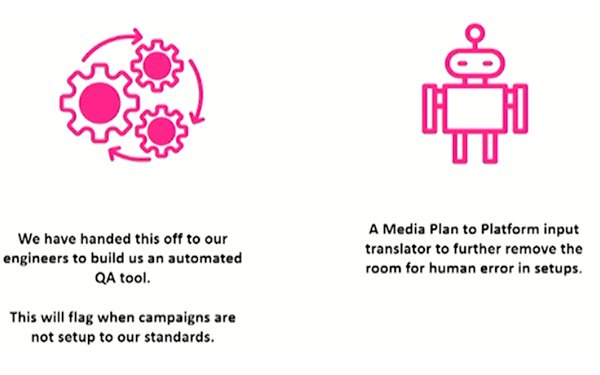
Removing human error in processes through automation
has become a priority at Reckitt, a British-Dutch multinational consumer goods company headquartered in Slough, United Kingdom.
The company’s engineers have been building templates and
tools through Google Display & Video 360 that alert marketers to missing ad placements in campaigns, or when brand safety parameters don’t match its global standards.
Now they
are working on an automated process to translate media plans directly into known file formats to remove the human process. The company already automates budgets, naming conventions, and labels
audiences. Changing the formats will help others understand the plan and remove human errors.
Brands have been chasing shiny objects and worried about ad blockers and mobile apocalypse as well
as cookies, General Data Protection regulation, and the rise of AI, Mikey Mizrahi, programmatic manager at Reckitt, told attendees at the MediaPost Data & Programmatic Insider
Summit.
advertisement
advertisement
“We have lost the plot in the pursuit of looking smart for clients,” he said, but one truism remains -- during the next 50 years company headcounts will always be
tight.
Mizrahi’s team set out to automate many processes, looking for inconsistencies and consistent inputs, and broke down each process into steps before automating systems to reduce
mistakes made in campaigns.
Baseline templates were created. Mizrahi called those templates “do not touch” lists for campaigns. They covered everything from frequency caps, brand
safety, and more. From these lists, engineers began building documents for marketers to follow. Budgets were not included.
While it once took about 10 hours to set up each campaign, these
automated processes reduced execution times by 90%.
“I don’t have to worry about brand safety or putting the ads in the wrong market,” he said.
Mizrahi said the team
looked for excel-based inputs on platforms and built automation around it using structured data files to break processes into steps before automating each to reduce mistakes made in campaigns. These
baseline templates have become a “do not touch list” for campaigns.
He said companies can apply these same tools and principles to The Trade Desk, Meta, Amazon or any project with
an excel-based input.
When companies follow standards it eliminates concerns that someone during the Monday morning call would say, “oh crap, I spent a thousand dollars or a million
dollars in the wrong market,” he said.